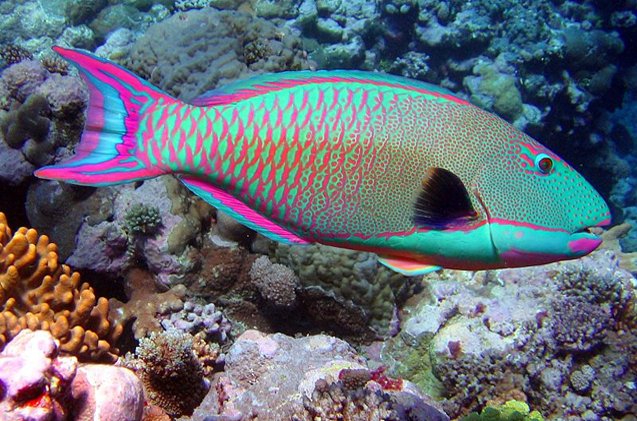Parrotfish


About Parrotfish
Parrotfish are a large family of marine fish made up of over 90 distinct species. They are characterized by their parrot-like beaks which are made of tightly compressed teeth. In the wild parrotfish use their beak-like mouths to scrape algae off corals. Adult parrotfish often bite off large pieces of coral when feeding in this way and contribute greatly to bioerosion in coral reefs around the world. Although a peaceful and extremely beautiful species of fish, their highly specific dietary requirements make them unsuitable for beginner and novice aquarists.
Parrotfish are a large family of marine fish made up of over 90 distinct species.
Parrotfish are found in the tropical and sub-tropical oceans across the world.
Most species are vibrantly colored and are adorned with fascinating color patterns and markings. They come in shades of red, blue, green, yellow, orange, grey and black.
One of the most challenging aspects of keeping parrotfishes is their very specific feeding habits. They enjoy grazing on coral and rock for algae and adult specimens can wreak havoc on a reef aquarium. Most species grow between 12-20 inches in length and should only be housed in large aquariums with sufficient swimming space. The aquarium should also be decorated heavily with rocks and live plants to provide numerous hiding places for the fish.
They are an extremely peaceful species of fish and make excellent additions to community aquariums. They may however prey on smaller species of fish and crustaceans on occasion.
Parrotfishes also excrete a mucus-like substance to form a protective cocoon around themselves in the night. When given adequate care and attention, parrotfish can often live for up to 13 years in captivity.
One of the most challenging aspects of keeping parrotfish is their very specific feeding habits.
Although parrotfishes feed primarily on algae, they can also be trained to accept shrimp and seaweed sheets.
Breeding parrotfishes in the home aquarium is difficult due to their large size.
Bicolor Parrotfishes, Princess Parrotfishes, Bowe’s Parrotfishes, etc.

Amy Tokic, Editor of PetGuide.com, is a passionate animal lover and proud pet parent of Oscar, a Shih Tzu/Chihuahua cross, and Zed, a Japanese Chin. Her love of animals began in kindergarten, when she brought her stuffed dog Snoopy into class with her every day. Now, she writes about her adventures in pet ownership and tirelessly researches products, news and health related issues she can share with other animal enthusiasts. In her free time, Amy loves perusing used book and record stores, obsessing over the latest pet products available and chasing squirrels with wild abandon (a habit attributed to spending too much time with her pooches).
More by Amy Tokic























